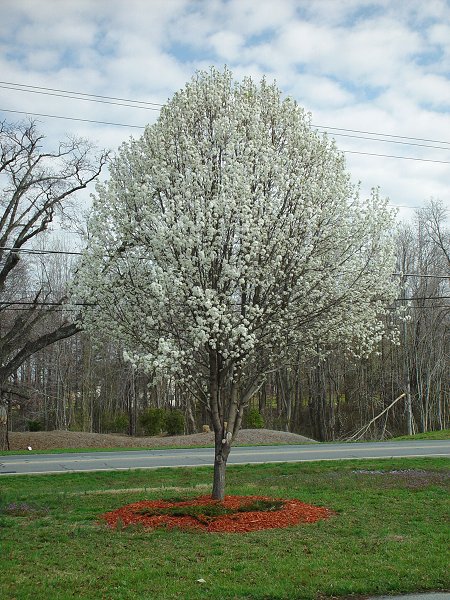Pyrus calleryana Decne.
Bradford Pear

Introduced
CC = *
CW = 5
MOC = 20
© DETenaglia
Pyrus calleryana Decne.Bradford Pear | |
 |
Introduced CC = * CW = 5 MOC = 20 |
© DETenaglia |
|
Family - Rosaceae Habit - Trees to 15 m tall. Stems - Typically with a single trunk, branching, pyramidal in form. Twigs glabrous or rarely short-hairy, the winter buds relatively large, the scales densely cobwebby-hairy and fringed. Thorns sometimes present. Leaves - Alternate, petiolate. Petiole 2-5 cm long, moderately hairy when young, nearly glabrous at maturity. Blade broadly ovate, truncate to slightly tapering at base, crenate-serrate, acuminate to acute, undulate, 4-9 cm long, shiny green above, light blue-green below. Surfaces cobwebby-hairy when young, glabrous at maturity.
Inflorescence - Flowers typically appearing before leaves on new seasons growth. Flowers in dense terminal domed to globose cymes to 7 cm broad, 7 cm long. Pedicels lanate to arachnoid pubescent, 2 cm long.
Flowers - Corolla rotate, to 2.8 cm broad. Petals 5, white, glabrous, orbicular, distinct, borne at edge of receptacle, 1 cm in diameter. Stamens typically 20, exserted. Filaments white, glabrous, to 7 mm long. Anthers reddish-purple, 1.2 mm long. Styles 2. Carpels 2, with 2 ovules each. Ovary inferior. Hypanthium 3-4 mm tall(long), lanate to arachnoid pubescent. Sepals 5, acuminate to triangular, lanate to arachnoid pubescent, 3 mm long.
Fruits - Pomes 0.8-1.5 cm long, globose to slightly oblong-globose, the surface green to yellowish brown or blackish brown, with pale dots. Seeds 1 or 2.
Flowering - March - April. Habitat - Cultivated, widely escaping to roadsides, fields, and forests. Origin - Native to China (Asia). Lookalikes - Several species of Prunus (cherry or plum). Other info. - P. calleryana is one of the first trees to bloom in the spring. The brilliant white flowers dominate the dull winter landscape of Missouri for a week or two. This species was introduced into cultivation in 1919. The "Bradford" cultivar was introduced to the U.S. in 1964. Other cultivars exist which have different color fall foliage and different growing characteristics. Fruits can be absent to many small reddish pomes about 1 cm in diameter. Photographs taken in Stokesdale, NC., 3-22-03 (DETenaglia); also near Labadie, Franklin County, MO, 3-31-2021 and 10-31-2021 (SRTurner). |